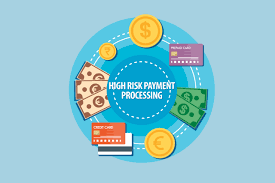AUTHOR : KYLIE SCOTT
DATE : 01/11/2023
In the dynamic world of commerce, businesses vary widely in terms of risk[1]. While some businesses operate in low-risk environments, others fall into the high-risk category.[2] Payment processing is a critical aspect of any business, but it becomes particularly complex when dealing with high-risk industries. This article delves into the intricacies of payment processing for high-risk businesses, shedding light on the challenges and solutions they face.
1. Introduction to High-Risk Payment Processing
High-risk payment processing refers to the handling of financial transactions for businesses or industries that are considered riskier by banks and also financial institutions. These businesses often face a greater likelihood of chargebacks, fraud, and also legal issues, making them challenging to support through traditional payment processing systems.
2. The Importance of Payment Processing
Efficient payment processing is the lifeblood of any business. It allows companies to accept payments from customers, facilitating sales and also revenue generation. For high-risk businesses, choosing the right payment processing solution[3] is paramount for their survival[4] and success[5].
3. Understanding High-Risk Businesses
High-risk businesses can encompass a wide range of industries, including online gambling, adult entertainment, nutraceuticals and also travel services, among others. These businesses are labeled high-risk due to factors such as a high rate of chargebacks, regulatory scrutiny, or a history of fraud.

4. Challenges in High-Risk Payment Processing
High-risk businesses encounter various challenges in payment processing, including difficulty in obtaining merchant accounts, higher processing fees, and also increased vulnerability to fraud. These challenges necessitate specialized solutions.
5. Choosing the Right Payment Processor
Selecting the appropriate payment processor is a critical decision for high-risk businesses. It is essential to partner with a processor experienced in handling high-risk industries, offering tailored solutions to mitigate risks.
6. Risk Mitigation Strategies
High-risk businesses need to implement strategies to reduce chargebacks and fraudulent transactions. These strategies may include identity verification, transaction monitoring, and also enhanced customer support.
7. High-Risk Payment Processing Fees
High-risk payment processing often comes with higher fees compared to low-risk businesses. Merchants should be aware of these costs and factor them into their pricing structure.
8. Regulatory Compliance
Adhering to industry regulations is crucial for high-risk businesses. Non-compliance can result in severe penalties and also the termination of payment processing services.

9. Security Measures
Security is a top priority for high-risk businesses. Implementing robust security measures, including encryption and also secure payment gateways, is essential to protect sensitive customer data.
10. Payment Gateway Solutions
Choosing the right payment gateway is vital for high-risk businesses. It should offer flexibility, scalability, and a seamless checkout experience for customers.
11. Chargebacks and Disputes
Businesses in the high-risk category often face a heightened susceptibility to chargebacks and disputes. Efficiently managing these issues is key to maintaining a healthy payment processing system.
12. Tips for High-Risk Merchants
High-risk merchants should focus on customer service, transparency, and effective communication to build trust and credibility within their industries.
13. Case Studies
Examining real-world case studies can provide valuable insights into successful payment processing strategies for high-risk businesses.

14. The Future of High-Risk Payment Processing
As technology evolves, so do the challenges and solutions in payment processing for high-risk industries. Staying updated and adapting to new trends is essential for sustained success.
15. Conclusion
In conclusion, payment processing for high-risk businesses is a complex but necessary aspect of their operations. By understanding the unique challenges they face and implementing the right strategies, these businesses can thrive in their respective industries. Choosing the right payment processor, prioritizing security, and staying compliant with regulations are crucial steps in this journey.
FAQs
1. What defines a high-risk business?
High-risk businesses are those that face a greater likelihood of chargebacks, fraud, and legal issues due to various factors such as industry type, chargeback rates, and regulatory scrutiny.
2. How can high-risk businesses reduce chargebacks?
High-risk businesses can reduce chargebacks through strategies like identity verification, transaction monitoring, and improved customer support.
3. What are the key considerations when choosing a payment processor for a high-risk business?
When selecting a payment processor for a high-risk business, it’s essential to consider their experience in handling high-risk industries, their fees, security measures, and regulatory compliance.
4. Why is regulatory compliance crucial for high-risk businesses?
Regulatory compliance is vital for high-risk businesses to avoid penalties, legal issues, and the potential termination of payment processing services.
5. How can high-risk businesses adapt to the evolving landscape of payment processing?
High-risk businesses can adapt by staying updated with the latest technology trends, maintaining a focus on security, and being proactive in addressing emerging challenges in their industries.
The online gambling industry is inherently high-risk due to the potential for chargebacks, fraud, and regulatory scrutiny. In this case study, we’ll look at how a prominent online casino successfully navigated these challenges.





